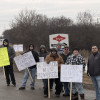We’re looking forward to our future. And we will have a future. You’ll see the results as time moves on.
Members, owners and contractors met in Plymouth, Massachusetts, for the biennial Northeast Tripartite. With an ever-increasing demand for clean energy, Boilermakers are working to gain a foothold in hydrogen energy production and offshore wind. Work potential is looking brighter in the Northeast Section with support from the M.O.R.E. Work Investment Fund.
“We’re looking forward to our future. And we will have a future,” IVP-NE John Fultz said as he opened the conference. “You’ll see the results as time moves on.”
Michael Murphy of Murphy Business Solutions is helping the Northeast secure more work for members through the M.O.R.E. Work Investment Fund. In his NextGen update, he shared ways locals in the Northeast can increase work and man-hours.
“The Boilermakers have been at the forefront of energy,” Murphy said. “Boilermakers have always been involved in what’s coming next.”
He said offshore wind on floating structures is low hanging fruit because fabrication for the structures requires a skilled workforce. With a potential of five million man-hours, he said it’s an industry to watch.
“To me, that has the largest opportunity for Boilermakers because of the floating system,” he said.
The first floating wind farm will need about 350 structures.
“We’re going to take shop work and put it on a barge,” Fultz said. “We’re building it here and then shipping it to where it goes.”
Murphy said Boilermakers must focus on getting the work now if these structures are to be built in the United States, or they will be built in Indonesia and floated to U.S. waters.
IR John Clark explained how the M.O.R.E. Work Investment Fund can help. He took attendees through its nuts and bolts, helping business managers, contractors and owners understand the process to request support from the M.O.R.E. Work program.
“For the employers, we want you to use M.O.R.E.,” Fultz said, noting that after an application is submitted, the request goes to a committee for review.
Bernard Brown of Empire Diversified Energy, Inc. detailed the company’s Anaerobic Digester project in Follansbee, West Virginia, for the Appalachian Regional Clean Hydrogen Hub or ARCH2. The U.S. Department of Energy selected the project as one of seven hydrogen hubs nationwide to receive funding from DOE’s Office of Clean Energy Demonstrations.
The Follansbee project is unique in energy production because it uses food waste and sludge to create hydrogen. Brown said the current cost to produce a kilogram of hydrogen is about $7. But Empire’s process costs $2.35, and that’s without a government subsidy.
“We’re taking food products that would be going to the landfill and making energy from it,” he said. “We get paid to collect the food waste.”
Empire will take food waste, that creates methane when it decomposes, put it inside a sealed, airtight digester and then capture the biogas.
Brown indicated that Empire would use Boilermakers to build the project from the ground up.
“You’re our allies. We need you to build a quality system that works,” he said.
If we get the unions involved and invested from the beginning, they’re going to build us a solid plant.”
He said whether the hydrogen hubs move forward, Empire is committed to building the plants.
“We want to be the best at clean energy,” he said.
Additional speakers included Director of Government Affairs Cecile Conroy, BNAP Coordinator Mark Wertz and NEAAC Administrator Jason Dupuis.









